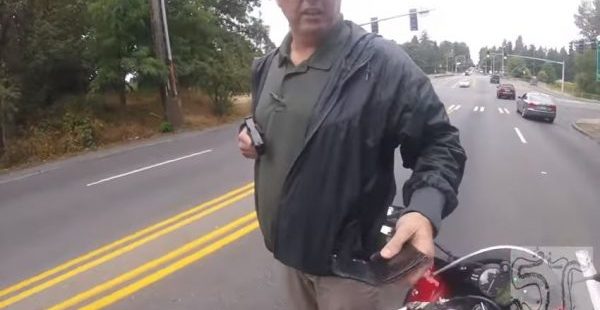
Disturbing video of a Washington State motorcyclist’s Aug. 16 confrontation with a King County Sheriff’s detective who approached with a drawn gun and did not immediately identify himself has gone viral and raised public second-guessing to a fever pitch.
When the Sheriff’s Department finally saw the video on Aug. 28, the detective was immediately placed on leave, and according to Sheriff John Urquhart, an investigation has been launched. Urquhart spoke to Liberty Park Press Tuesday, explaining that stopping someone for reckless driving typically doesn’t, nor shouldn’t, involve a drawn sidearm.
The incident raises some questions:
Had the motorcyclist, identified as Alex Randall by the Seattle Times, been speeding and riding erratically prior to the incident? That’s being suggested by some, and at the start of the video if one looks quickly, they will see “49” on his digital speedometer.
What would happen if an armed private citizen engaged in similar behavior?
There are laws against threatening the use of lethal force, but where police are concerned, there is a Supreme Court ruling from 1989 (discussed below) that has some interesting perspective. But it regards a case involving police.
An armed citizen would not have the benefit of being “placed on leave” but instead quite possibly be arrested and jailed, and face charges that might include first-degree assault.
Urquhart said he contacted Randall via telephone and apologized for the incident.
On the video the detective can be heard threatening to “knock” Randall off his motorcycle.
But what about the drawn gun? A careful review of the video does not appear to show that the plainclothes detective put his finger on the trigger, as some critics have asserted on social media. It appears that the detective’s trigger finger was “indexed” along the pistol’s frame, a text book placement that is universally taught in defensive firearms training courses.
Still, the question remains: What might happen to a legally-armed Washington State citizen who did the same thing, under the same circumstances, knowing what the detective knew at the time? Under Washington statute 9A.36.011, which discusses first-degree assault:
Assault in the first degree.
(1) A person is guilty of assault in the first degree if he or she, with intent to inflict great bodily harm:
(a) Assaults another with a firearm or any deadly weapon or by any force or means likely to produce great bodily harm or death; or
(b) Administers, exposes, or transmits to or causes to be taken by another, poison, the human immunodeficiency virus as defined in chapter 70.24 RCW, or any other destructive or noxious substance; or
(c) Assaults another and inflicts great bodily harm.
(2) Assault in the first degree is a class A felony.
However, temper this discussion with a look at a 1989 Supreme Court ruling in a case called Graham v. Connor, which discussed claims of excessive use of force by law enforcement. The opinion was authored by the late Chief Justice William Rehnquist. Urquhart mentioned it in his telephone conversation.
Briefly, a man named Dethorne Graham had been detained by law enforcement during what turned out to be a diabetic incident in Charlotte, N.C.
Graham and a friend were stopped by a police officer to determine whether something illegal had occurred at a convenience store when the friend stopped to try to purchase some orange juice for the ailing Graham. The friend went inside, saw a long line at the check-out counter and rushed back outside to merely drive Graham home.
During Graham’s detention, he was handcuffed and, according to the decision, “At some point during his encounter with the police, Graham sustained a broken foot, cuts on his wrists, a bruised forehead, and an injured shoulder; he also claims to have developed a loud ringing in his right ear that continues to this day.” So, he filed an action in federal court.
That case applied to the use of force by police. Again, what might happen to the private citizen who confronted someone in the same manner? Would that person face criminal charges? Should such a confrontation even occur? The quick answer is that armed private citizens shouldn’t do this sort of thing. Get a license plate number if possible and call the police.
The detective in this case apparently did not immediately identify himself. In the video, he appears from the left, gun in hand and held tightly to his chest.
What might someone assume if he or she was approached and confronted in the same manner? Washington State self-defense law allows the use of deadly force “In the actual resistance of an attempt to commit a felony upon the slayer, in his or her presence, or upon or in a dwelling, or other place of abode, in which he or she is.”
This incident could have had all kinds of outcomes, and it may not end well even now. Time and a thorough investigation will sort all of this out.
Cooler heads will hopefully prevail.